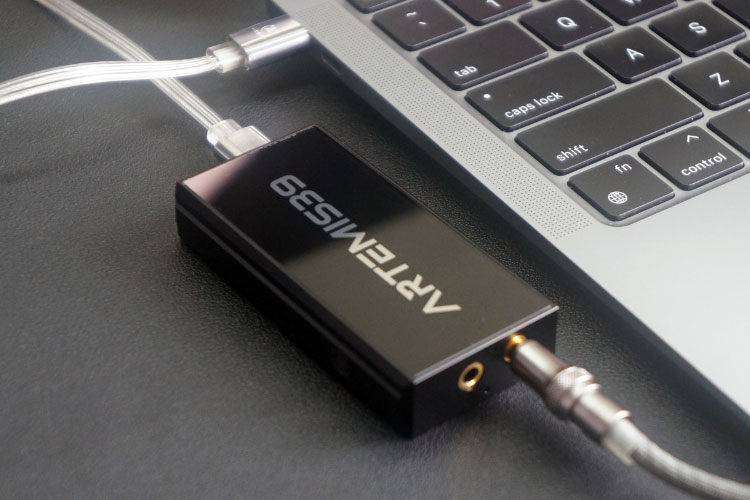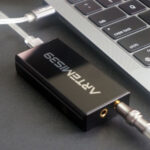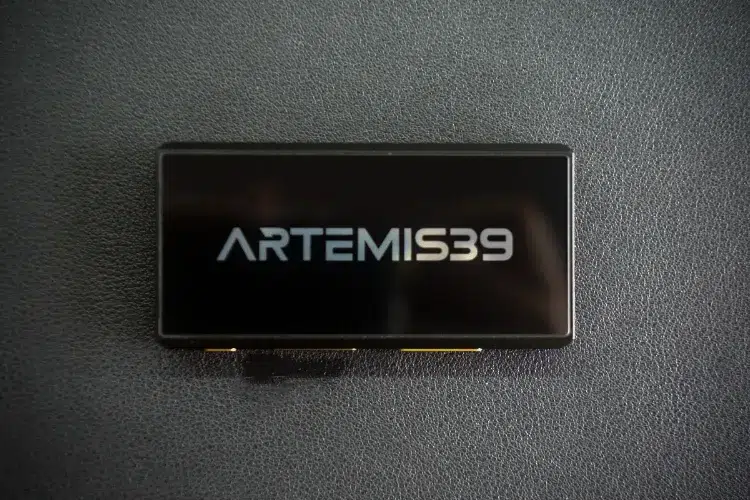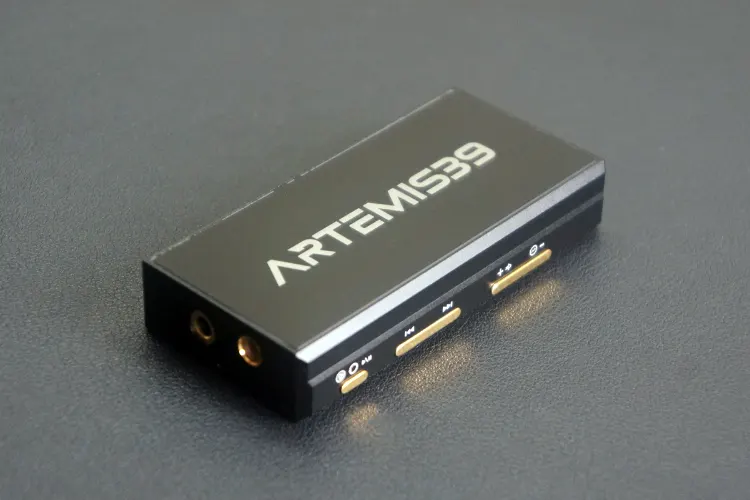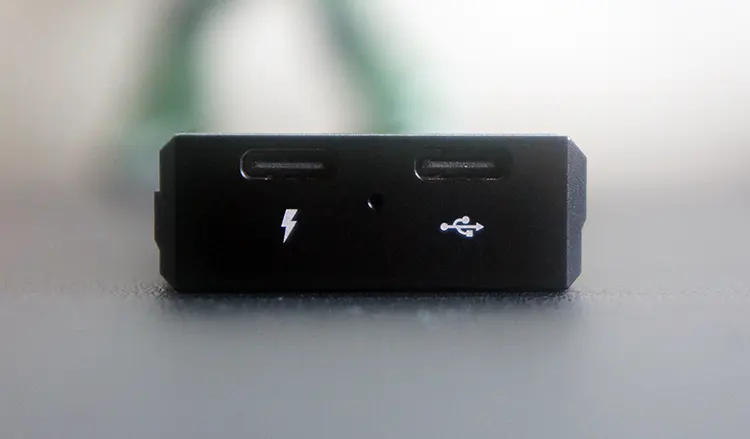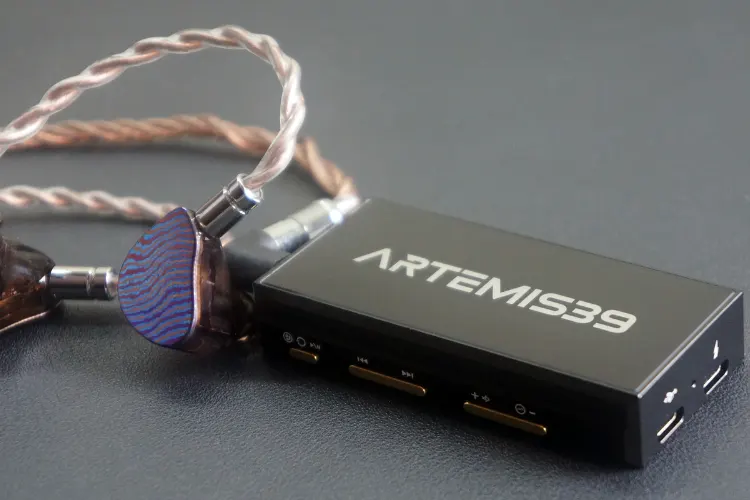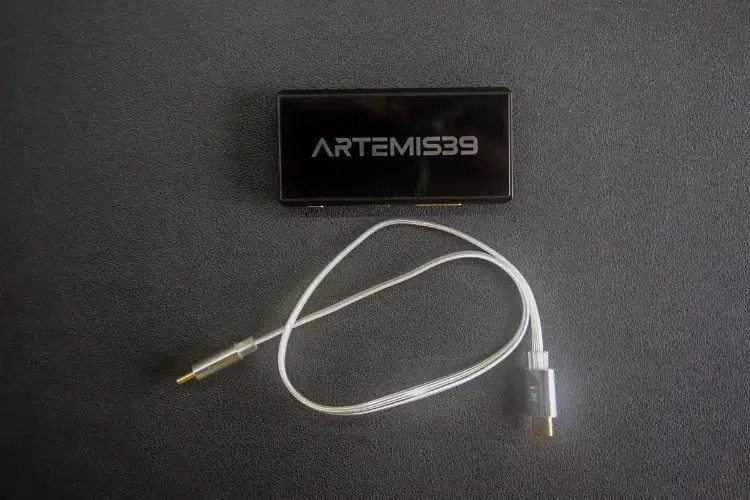Meldrick reviews the 7Hz Artemis39, a wireless ES9039Q2M dongle DAC offering LDAC decoding, DSD256, and up to 405mW of balanced output power. It is priced at $149.
Disclaimer: This sample was sent to me in return for my honest opinion. Headfonics is an independent website with no affiliate links or services. I thank the team at Linsoul for giving me this opportunity.
Click here to read more about 7Hz products we have previously reviewed on Headfonics.
Note, that this article follows our latest scoring guidelines which you can read in more detail here.
Known for popular IEMs such as the Aurora and the Timeless, 7Hz is entering new territory with the release of the Artemis39, the brand’s first wireless portable DAC/AMP.
Coming in at the top of the brand’s portable source lineup, the Artemis39 includes a comprehensive suite of Bluetooth codecs and support for both 3.5mm SE and 4.4mm balanced, while wrapping it all in an attractive glass and metal package.
You can read my full review below to learn how 7Hz’s inaugural entry into the wireless dongle space performs and compares against competitors such as the Kiwi Ears Allegro and FiiO’s new BTR13.
Features
Quite surprisingly, the Artemis39 manages to fit an ESS ES9039Q2M DAC Chip into its portable shell.
This is a DAC Chip that was once found in mid-range dedicated desktop models such as the SMSL D-6S, letting the Artemis39 reproduce a clean sound signature while maintaining efficient heat and power management.
Powering the Artemis39 is a large 1100mAh battery, giving the unit a rated battery life of 8-10 hours. This adds an extra layer of convenience to the Artemis39, ensuring that it needs to be charged less frequently compared to other more popular dongle DACs in the price range.
The inclusion of an onboard microphone is a nice quality-of-life feature that aids in the daily use of the Artemis39.
With most audiophile-grade IEMs and headphones no longer including an in-line mic, the Artemis39 provides a convenient way for on-the-go audiophiles to take calls or interact with their phone’s digital assistant.
Design
The 7Hz Artemis39 is built from an anodized metal frame sandwiched between two flat panels of glass, giving it a sleek yet monolithic appearance. Despite having a rectangular form factor, the chamfered edges make it comfortable to hold during daily use.
In my testing, the anodized metal frame was resistant to scratches and fingerprints. However, the glass panels were a ‘fingerprint magnet’, easily highlighting thumb marks even after just a partial touch.
This large glass panel also became vulnerable to micro scratches that occur in daily use. When perfectly clean, the glass panels give it a premium look and feel. However, the difficulty of keeping the glass panels clean often leaves the Artemis39 looking somewhat dirty.
The Artemis39 is finished in black or red, with my sample being the black version. The gold buttons on the side of the unit create a subtle visual flare that keeps the overall package from being too monotonous.
The font of the unit has a large ARTEMIS39 placed across the glass panel, with a comparatively smaller 7Hz logo placed at the back panel. The 7Hz logo at the rear of the unit is only visible when the unit’s LED is turned on.
The 2 USB-C ports on the bottom of the unit are intuitively marked with engraved icons that help to identify which port is for data or charging.
The tolerances of these USB-C ports, and the 3.5mm and 4.4mm ports on the other end, were good, making cable connection secure yet convenient.
I/O
The top of the Artemis39 houses horizontally aligned 3.5mm and 4.4mm jacks with a small cutout for the microphone placed right under.
SE output ensures compatibility out of the box with more affordable IEMs that pair well with dongles in this price range, meanwhile, the 4.4mm output ensures the dongle remains useful when listeners experiment with pricier balanced cables and IEMs or headphones that require more power.
The bottom of the unit houses 2 USB-C ports, one dedicated for charging and one dedicated for data.
I appreciated this feature since it ensures that in wired mode, the Artemis39 gets its power from the included 1100 mAh battery instead of the source device’s battery.
The Artemis39’s last input option is its Bluetooth connectivity, supporting LDAC, APTX-HD, APTX-LL, APTX, AAC, and SBC codecs, enabling compatibility with a wider range of devices.
Controls
Being a portable wireless dongle, volume and track control is dependent on the on-device controls. In Windows, macOS, and iOS, I experienced no issues with the on-device controls, both in wired and wireless modes.
The volume controls and track controls are implemented through separate small, flat rockers that protrude slightly from the cut-out on the right side of the unit. They have nice tactile feedback while also remaining silent.
The unit’s power button is a tactile microswitch with deeper travel and stronger tactile feedback than the rocker controls. All buttons are easy to press but have sufficient firmness and stiffness to avoid any accidental presses.
The unit’s intuitive control scheme did a good job of being unobstructive, letting me control my music without needing to reach for my phone or computer.
Packaging & Accessories
The DT03 comes in a simple white box that includes:
- The 7Hz Artemis39 Dongle
- Flat USB-C to USB-C cable.
The Artemis39 comes with the bare minimum needed for daily operation. However, since it comes with 2 USB-C ports, I would have appreciated the inclusion of at least 2 USB-C to USB-C cables.
The addition of a USB-C to USB-A adapter would have also made the Artemis39 compatible out of the box with older desktop and laptop computers.
Sound Impressions
All testing and comparisons were done through 3 pairs of IEMS, namely the Moondrop Blessing 3, the Yanyin Canon II, and the 7Hz Aurora, as well as the Audio-Technica R70x and Sennheiser’s HD 580 Precision full-sized headphones.
Bass
With a neutral sound profile that leans toward the upper mid-range and lower treble, the Artemis39 has a bass presentation that is tight and intentional.
Each hit from bass drums has a good sense of rumble and depth, without artificially boosting the bass to overpower the other instruments in the mix.
Bass guitars and low-end synths have a clean presentation that highlights details without being too overwhelming, however, they do not have the same atmospheric sound that I’ve observed on warmer sources.
Bass tones, especially bass guitars, are particularly well textured, with each strum in complicated riffs having unique tones and harmonics. Wired mode highlights texture and nuances in bass strums and percussive strikes even further.
The texture and detail difference between wired and wireless modes are not that glaring and only identifiable through A-B testing. However, I find this a fair tradeoff given the convenience improvement of the unit’s wireless connectivity.
This tight yet controlled bass performance may not have enough warmth for some preferences, but this preserves an energetic mid-range with a clean yet detailed presentation of instruments.
Mids
The Artemis39 has a clean, neutral-sounding mid-range, placing emphasis and energy through the upper mid-range, specifically with female vocals.
Acoustic mid-range instruments such as pianos, organs, and guitars have a natural-sounding timbre that never sounds artificially boosted or metallic. Each strike and piano key comes through with good harmonics, ensuring each instrument within the mid-range is easily identifiable from one another.
Higher-pitched electric guitars, as well as female vocals in more modern pop music, have a slightly more forward presentation compared to the other instruments in the mids. This also gives them a more energetic presentation.
Jazz and jazz-fusion tracks benefit from this tuning choice, highlighting a natural-sounding timbre for vocals and string instruments, whilst also playing back the mix with enough energy to add excitement to the complex jazz arrangements.
When connected over Bluetooth wireless, the sound staging performance takes a small hit because of the Bluetooth compressions. Connecting to the source devices via a wired connection yields a clearer presentation of instruments and better imaging performance.
Treble
The Artemis39 has an airy, detailed treble presentation that is not too fatiguing. Cymbals and chimes are played back with good energy and enough fidelity to make individual crash and hi-hat cymbals easily distinguishable.
This drives the track with a strong sense of energy that comes through very clearly in complex jazz arrangements. The rhythmic striking of different cymbals cuts through the mix and provides the whole track with an energetic backbone.
Brass instruments also have a forward presentation, giving them a thick, weighty impact that can be felt throughout complex mixes.
When connected over Bluetooth wireless, the Artemis39 exhibits some sibilance on the high end of the treble region. Connecting to the source devices via a wired connection gives the Artemis39 better extension and contributes to a less fatiguing sound signature.
Staging and Dynamics
The Artemis39 excels in reproducing sound with good note weight and dynamics. It does not fundamentally change the presentation of the paired IEMs or headphones, but it does offer an incremental improvement that makes individual notes sound more textured and weightier.
In complex jazz-fusion tracks, the improvement in dynamics aids in the clearer separation between different instruments in the mix, highlighting the nuances of the track in a more easily distinguishable manner.
The Artemis39 does not have the same atmospheric width as warmer sources, but good dynamics performances improve its imaging and positioning accuracy.
Click on page 2 below for my recommended pairings and selected comparisons.

